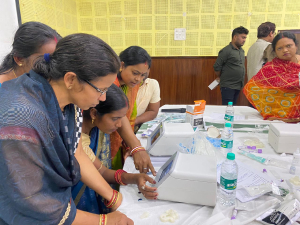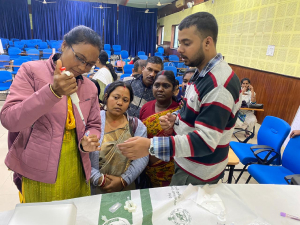HemexDx
Diagnostics for Sickle Cell Disease and Beta-Thalassemia


CURRENT IMPACT
As on April 2024
580+
devices deployed
1000+
healthcare workers trained
80,000+
tests conducted

Geographical Focus
- Assam, Bihar, Odisha, Jharkhand, Maharashtra, and Madhya Pradesh

Potential Impact
- Establish
590
testing centers - Screen
2
million people for SCD and beta-thalassemia

Patricia White, Director, HemexDx

Our partnership with SAMRIDH goes beyond financial assistance; it embodies a mutual dedication to enhancing healthcare accessibility and uplifting women and children within our communities. SAMRIDH’s assistance through the blended financing model has allowed us to extend our reach to more communities, aligning perfectly with our values of inclusivity and gender equality. This approach enables us to leverage public and private resources, ensuring maximum impact and sustainability for our endeavors.

Samridh support
SAMRIDH, through its recoverable grant initiative, is supporting HemexDx in scaling its reach in rural and remote areas in 8 states. The enterprise aims to test over 2 million individuals using Gazelle™ during SAMRIDH’s first year of support, with a particular focus on reaching 50% females. The financial assistance also enables Hemex to establish 590 strategically located testing sites, facilitating efficient delivery of results to patients and the healthcare system. The Hemex group will further raise an additional $5 Mn to advance the reach and impact of their healthcare solution, which would account for a leverage of ~19.6x over SAMRIDH support.
20 Mn+ people in India are diagnosed with Sickle Cell Disease (SCD). [1]
20% of tribal children with Sickle Cell Disease (SCD) don’t survive past age 2, and 30% don’t make it to age 25. [2]
~10,000 to 15,000 babies in India are born with Beta-Thalassemia Major (BTM) each year. [3]
~150,000 patients are diagnosed with thalassemia major in India each year. [4]
~3.6 to 3.9 crore individuals in India are carriers of beta-thalassemia. [5]
India bears a significant burden of hemoglobinopathies, with Thalassemia and Sickle Cell Disease (SCD) being the most prevalent. SCD and beta-thalassemia are particularly common among the tribal population residing in remote areas with limited healthcare access. There is no widespread newborn testing for SCD or premarital testing for the sickle cell trait in the country. The Government of India has initiated a mission to eradicate sickle cell anemia by 2047, emphasizing awareness, universal screening for approximately seven crore people aged 0-40 in affected tribal areas, and counseling. This ambitious endeavor requires concerted efforts from central ministries, state governments, the National Health Mission’s National Sickle Cell Anemia Elimination Mission (NSCEM), and the private sector to effectively and affordably address remote communities’ needs.
[1] ET Online. 2023. “Sickle cell disease, which affects 20 mN Indians, can cause poor immunity, blindness.” : The Economic Times, June 19, 2023.
[2] Ministry of Tribal Affairs. 2021. “M/o Tribal Affairs organises the second National Conclave on Sickle Disease in India on World Sickle Cell on 19th June, 2021.” Press release. June 19, 2021.
[3] Mukherjee, Tulika Chandra and Anubha Taneja. 2022. Blog, May 4, 2022. “Impact of pandemic and way forward for thalassemia patients in India.” Times of India Times of India Blog, May 4, 2022.
[4] Ibid
[5] Ibid


HemexDx’s Gazelle™ solution, an innovative ‘Made in India’ healthcare product, addresses India’s and Africa’s unique requirements by providing affordable and portable hemoglobin variant identification. This includes screening for conditions like sickle cell disease, sickle cell trait, and beta-thalassemia. Engineered for remote settings, Gazelle operates in temperatures up to 45°C, runs on battery power all day, and delivers hemoglobin analysis in 8 minutes with on-screen interpretation. The solution enables local and convenient testing and aids healthcare professionals in accessing valuable clinical information. Moreover, as it is tailored for identifying hemoglobin variants, it assists in early disease detection and subsequent medical intervention. Gazelle shines with its ability to screen for multiple conditions from a single blood sample, eliminating the need for separate tests and streamlining the process. Additionally, it creates digital records linked to patient IDs, enhancing diagnosis efficiency and enabling the identification of prevalent diseases in various regions across India based on geographical data. This innovation, based on electrophoresis and enhanced with AI image analysis, miniaturizes and automates the testing process, making it accessible even to less-skilled technicians outside traditional laboratory settings.
Key Stakeholders


